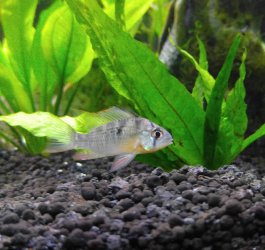You are using an out of date browser. It may not display this or other websites correctly.
You should upgrade or use an alternative browser.
You should upgrade or use an alternative browser.
Sexing help
- Thread starter Cami39
- Start date
The December FOTM Contest Poll is open!

🏆 Click to vote! 🏆
Sexual dimorphism in this species (Mikrogeophagus altispinosus) is rather limited with males larger in size and showing longer extensions on both the caudal and the posterior of the dorsal fins; these characteristics are more reliable in mature fish. Examination of the ovipositor can sometimes also indicate sex with the female displaying a larger, rounder appearance to pass eggs through, while the male displays a more pointed appearance; this may only be evident when the fish is ready to spawn.
The interaction of the fish may be a good indicator. Two males will almost continually be challenging if not physically attacking each other. Two females less likely to bother about the other. And a pair will usually show some interaction that is rather difficult to put into words; pairs however need to accept each other if long-term stability is to occur, so their behaviour to each other may suddenly change, or vacillate from time to time.
I'll attach a photo I found online that shows a pair over their clutch of eggs, the male the upper and the female the lower fish. The female's thicker ovipositor is just barely visible, and the extended fins on the male are quite developed.
Byron.
The interaction of the fish may be a good indicator. Two males will almost continually be challenging if not physically attacking each other. Two females less likely to bother about the other. And a pair will usually show some interaction that is rather difficult to put into words; pairs however need to accept each other if long-term stability is to occur, so their behaviour to each other may suddenly change, or vacillate from time to time.
I'll attach a photo I found online that shows a pair over their clutch of eggs, the male the upper and the female the lower fish. The female's thicker ovipositor is just barely visible, and the extended fins on the male are quite developed.
Byron.
Attachments
Similar threads
- Replies
- 3
- Views
- 538
- Replies
- 10
- Views
- 2K
- Replies
- 18
- Views
- 669
- Replies
- 4
- Views
- 343




